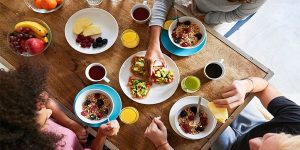What is live food? (No, I don’t mean what you find in the back of the fridge!) The simplest definition is that it has high vibration quality. If we could measure the potential energy (on a subtle level) of living food, it would be filled with life force energy ready to be easily absorbed by the consumer.
More than ten years ago, I learned about the concept of living books through the work of Charlotte Mason, a British educator of the early 20th century. Her philosophies have completely changed my approach to homeschooling and how I use books. I discovered many similarities between feeding our minds live books and feeding our bodies a healthy diet of live foods.
Mason defined a living book as a “complete” book that nurtures the soul on several levels. Much of the classical literature fits into this category, as do the biblical books of all traditions. The defining characteristic of a living book is that it can be read over and over again and there is always something else to learn or learn.
Mason described books that are a waste of time, that do not feed the soul, as “nonsense.” It is a kind of junk book. Furthermore, few textbooks can be considered living books because their history is often stripped from them, leaving only specific points that are recognized as important.
Live foods, like living books, are complete. Whole foods don’t lose their nutrients through over-processing or separating selected portions and discarding the rest. Just as the living books were not stripped of their humanity, their history, nor were they abbreviated or neglected. All parts work synergistically to create something bigger.
Live foods please the palate, nose, eyes, and even ears (think fried vegetables or grilled steaks). If you don’t like to eat it, the nutritional value of the food will not be well absorbed. (If you don’t think so, check out this wonderful study: Leif Hallberg, E. Bjorn-Rasmussen, et al., “Iron Absorption from Southeast Asian Diets. II. The Role of Different Factors That May Explain the Decrease in Iron absorption “, Journal of Clinical Nutrition 30 1977): 539–48.
Live foods are not “nonsense” or garbage. Junk food is generally created simply to be attractive and not have real nutritional value. Junk food is often subjected to intensive industrial processing that destroys most of the nutrients. These usually come in a shiny box or bag and are heavily advertised. Do you know what they are.

In some cases, live food is actually alive. They contain probiotics (“live and active” beneficial bacteria) that promote digestive health. Also, we refer to enzymes in food as “live,” even though they’re really just specialized protein molecules. Enzymes are destroyed or “killed” in food that has been heated to high temperatures.
Growing or fermenting food increases the levels of probiotics, vitamins and enzymes and reduces the levels of antinutrients, such as phytic acid and enzyme inhibitors, making the nutrients easier to absorb. Examples include yogurt, kefir, some types of cheese, traditional sauerkraut, pickles, and sourdough bread.
Unlike the words in books, which can last indefinitely, most foods will degrade and lose vital energy over time. Fermentation (where another organism is added to the food to be grown) can prolong and enhance the vital energy of the food. For example, sauerkraut (fermented with milk) contains 50% more vitamin C than raw cabbage.
In a living book, the energy of the writer is transmitted to the reader in the written words. Live foods are created or prepared with love and purpose. They are imbued with the energy of their Creator (and the energy of the Earth and its Creator). Think about this when shopping for your food.
Before eating, think about the source of your food. In gratitude, bless the food and those who prepared it for you. Remember to look for live foods that you like and make them a part of every meal.
Bonnie Thompson is passionate about living food, healing, and education.
If she had what she wanted, everyone in the world would learn Healing Touch and EFT and use these excellent tools for themselves, their families and friends.


